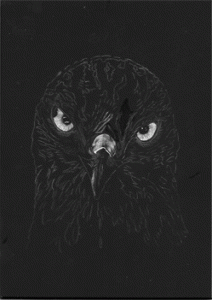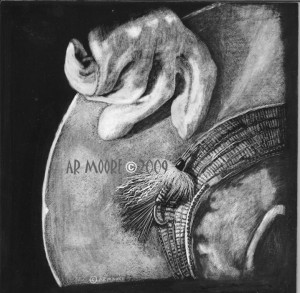3/25/2010-Recently I began to get interested in scratchboard. What is Scratchboard you may ask- I have put together a basic description of what it is and how it is done. Scratchboard is a form of direct engraving where the artist scratches away a thin surface coat of indigo ink to expose a white kaolin clay surface.
The scratching is done with a variety of tools, ranging from craft knives, scalpels, diamond and ruby-tipped burrs, sandpaper, steel wool, electric and ink erasers, sewing needles, tungsten welding rods, fingernail buffers, fiberglass brushes or just about anything hard enough to leave a mark. Scratches made with knives and scalpels are among the finest drawing lines possible. This allows the artist to build from darks to lights by layering numerous marks in the same area which lends itself particularly well to fur and hair, which is why wildlife and animals are favorite subjects of scratchboard artists. The boards can be left black & white or colored with inks, watercolors, or colored pencil. Typically the added color is itself scratched. Because of the many fine lines, creating a scratchboard is typically a slow process and it’s not uncommon for an artist to spend 40-200 hours on an original work. After a work is completed, it is varnished for protection. Most of today’s artists work on boards made by the US Company Ampersand, who supports the clay on a hard Masonite panel. I intentionally do not frame my work. The boards themselves allow a great variety of ways the owner of a piece of work, can frame them. I prefer not to place them under glass or plexi glass due to the glare and it is a detractant to the work and the vast amount of detail itself.
The amount of time a scratchboard takes depends on several things; size of the board, subject matter, intricacy of the subject, if using color or not, how much detail to use as the background, and on occasion how you might frame the completed work.
I have uploaded a sample of a practice board that I have animated from beginning to near completion. 
I hope you enjoy seeing the process.
Anderson



